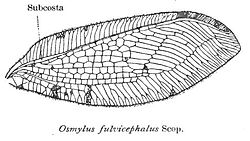| Osmylidae Temporal range: | |
|---|---|
 | |
| Porismus strigatus , Black Mountain, Canberra (Australia) | |
| Scientific classification | |
| Kingdom: | Animalia |
| Phylum: | Arthropoda |
| Class: | Insecta |
| Order: | Neuroptera |
| Superfamily: | Osmyloidea |
| Family: | Osmylidae Linnaeus, 1758 |
| Subfamilies | |
See text | |
Osmylidae are a small family of winged insects of the net-winged insect order Neuroptera. The osmylids, also called lance lacewings, stream lacewings [1] or giant lacewings [note 1] , [2] are found all over the world except North and Central America. There are around 225 extant species. [3]


